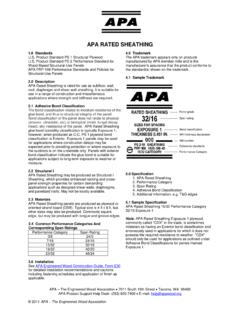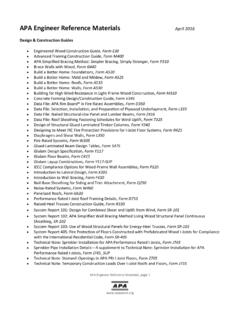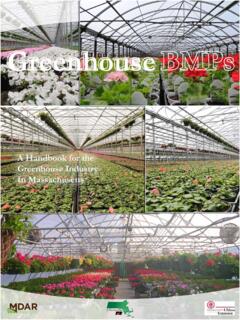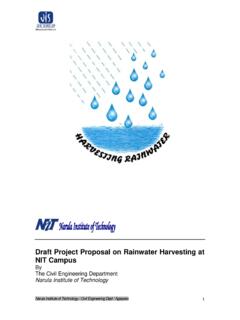Transcription of W FlooR Foundations - APAwood.org
1 Raised Wood FlooR FoundationsDESIGN & CONSTRUCTION Raised Wood FlooR ProcessPIER AND BEAMGIRDERSJOISTS1 GETTING STARTEDFOuNDATIONS23 FlooR FRAMING4 OThER CONSIDERATIONSCONTINuOuS STEMWAllSITE CONDITIONSSOIl PROPERTIESWOOD PIlINGMASONRY PIERWOODMASONRYluMBERGlulAMTRuSSESluMBER MOISTuRE MANAGEMENTINSulATIONR aised Wood Floors Southern Forest Products Association to a Higher StandardSatisfying the higher expectations of today s homebuyer presents new challenges. Meeting these challenges begins with a raised wood FlooR foundation that enhances curb appeal and provides many other raised wood FlooR Foundations , building professionals Noticed. Builders of raised wood FlooR homesdistinguish themselves from the competition by establishing a reputation for being green and progressive. Competitive. The aesthetics and amenities of raised FlooR homes make a positive impression on homebuyers, which may result in faster, more profitable sales. A raised wood FlooR foundation can also be the cost-competitive solution, especially in locations with elevation requirements, problematic soils, sloping terrain or where extensive site preparation is Schedule.
2 Lengthy concrete slab delays due to poor weather, time-consuming forming and curing, trade scheduling problems, extra inspections, or hauling and compacting of fill dirt can be avoided with raised wood FlooR The Upgrade. Homebuyers appreciate features of a raised foundation a front porch, screened back porch or sunroom, or a backyard professionals who elevate with raised floors framed with strong, renewable wood products create value for themselves and their clients. With the know-how to properly design and construct a raised wood FlooR , building professionals can build homes faster and more cost publication provides basic design guidance and construction details for raised wood FlooR Foundations . The pictorial to the right illustrates the four main sections Getting Started, Foundations , FlooR Framing and Other Considerations and the features included within each section. Cost-Saving Strategies are also provided. For more information, visit 2017 Southern Forest Products Association PAGE 9 PAGE 4 PAGE 11 PAGE 3 SuBFlOORDESIGN CONSIDERATIONSCONNECTIONSWOOD POSTCONCRETE PIERCONCRETEWAll, VENTEDCRAWlSPACESNAIl lAMINATEDlAMINATED VENEER luMBERPlYWOOD OR OSBI-JOISTSDECKSPORChESFINIShING & TRIMuNIVERSAl DESIGNPEST MANAGEMENT2 ClOSED, uNVENTEDC opyright 2017 Southern Forest Products Association Raised Wood Floors Southern Forest Products Association assessment and preparation steps are no different for a raised wood FlooR than for any other type of foundation system.
3 Architects, engineers and local municipal agencies within a jurisdiction can provide information specific to flood zones, design wind velocity, seismic design category, slope stability and other factors for construction when selecting the optimum type of raised FlooR clearing and excavation methods follow standard practices. Compacted backfill should be free of organic materials, including tree stumps or other vegetation, voids, chunks of clay and should be no more permeable than the surrounding wood FlooR assemblies may be constructed in any soil type. In fact, they perform very well even in problematic soils, such as expansive clays. The type of soil and the general grading conditions at the building site are important factors in determining foundation construction details, such as footing design and placement, backfill, and selected engineering properties of soils can be determined in several ways, including: published soil maps from government agencies, site borings, a review of borings from nearby sites, or other geophysical tests.
4 It may be necessary to consult a geotechnical engineer when any unusual or unknown soil conditions are elements of a raised wood FlooR system must be properly sized and assembled to support the design loads. A continuous load path must be provided to transfer lateral and vertical loads from the roof , walls, and FlooR system to the load path can be thought of as a "chain" running through the building. Because all applied loads must be transferred to the ground, the load path chain must connect to the foundation. To be effective, each link in the chain must be strong enough to transfer load without breaking. Suitable uplift, lateral, and shear connections are also required to complete the load strong continuous load path is especially important in areas subject to high winds and/or seismic design, specification and installation of fasterners and connections are crucial to the long-term structural integrity and performance under load. Nails used alone or in combination with metal framing anchors and construction adhesives are the most common method of fastening framing lumber and sheathing panels.
5 Metal fasteners in contact with pressure-treated lumber must be joints provide optimum performance when loads are applied at right angles to the shank. Nailed joints with the load applied parallel to the shank (in withdrawal) should be ConditionsSoil PropertiesDesign ConsiderationsConnectionsGetting Started3 Copyright 2017 Southern Forest Products Association Raised Wood Floors Southern Forest Products Association long-term durability and trouble-free performance, a raised wood FlooR foundation must be capable of accommodating all design loads and transferring those loads to the soil without excessive settlement. Before construction begins, an understanding of site and soil characteristics, specific design considerations and suitable connections is and BeamWall SheathingSill SealerBand JoistSubfloorFloor JoistUplift, Lateral, andShear Connections as RequiredThrough BoltsGirderNotched Piliing forGirderTreated Wood Piling(UC4B)*Vapor Retarder(Best Practice) Piling Depth VariesPressure-treated wood piles are a common foundation for homes built in beachfront locations, as well as in other areas where soils have minimal bearing capacity.
6 The cross-sec-tion area of a pile has little to do with its bearing capacity. The actual bearing support of the pile is the surface friction of the sand or soil encapsulating the pile below beachfront construction, the length of the pile below finished grade is typically the same length as the pile above grade, or longer. In other pile applications, the length of the pile below grade may be several times the length of the exposed pile subject to the soil properties providing friction girders to piles is a simple process with appropriately sized bolts connecting the assembly to resist loads. Cantilevered FlooR joist systems are sometimes preferred in conjunction with this type of foundation in order to allow tolerance for pile placement. In coastal areas, fasteners should be a minimum of hot-dip galvanized G185 or stainless Wood PilingA home s finished appearance will always influence the selection of the foundation type for a raised wood FlooR home. But with many varieties of foundation types available, raised FlooR homes can be built anywhere, meeting virtually any design may be continuous a continuous foundation wall around the structure s perimeter.
7 Or, footings may be specified for the installation of isolated piers or posts supported by a grade beam. Or, they may be isolated (spot footings) for foundation piers or Foundations offer a high level of versatility, specific not only to the dead, live, seismic and wind loads to be supported and/or restrained, but also to the girders or sill beams and FlooR joists and their respective span enclosed Foundations for raised wood FlooR construction are typically specified with continuous foundation walls, often called stemwalls. Stemwalls require continuous footings, but this design replaces the need for girders providing continuous support to single sill plates and the structure with pier construction, stemwalls may be built with a variety of materials including concrete masonry units (CMUs), formed concrete, as well as wood foundation walls, each providing versatility of design and many options for exterior 2017 Southern Forest Products Association Raised Wood Floors Southern Forest Products Association *Refer to the 2017 AWPA Book of Standards; : Specification of the proper preservative retention level is important for pressure-treated wood components of a foundation piling, posts, sill plates and framing (where required).
8 FoundationsPier and BeamWall SheathingSill SealerBand JoistSubfloorFloor JoistGirderUplift, Lateral, andShear Connections as RequiredTreated Sill Plate (best practice)Termite Shield (optional)Reinforced MasonryVapor Retarder (best practice)FootingRebarPerimeter Masonry Pier on Grade BeamInterior Masonry Pier on Spot FootingWhere soil bearing of sufficient capacity and stability exists, spot footings are often more cost efficient than continuous piers placed on spot footings to support FlooR -frame systems at the interior of the structure are typically not subject to either lateral or uplift loads, and therefore may not require the same reinforcement as those at the exterior perimeter, subject to pier or anchors that provide stability throughout FlooR -frame construction will typically require only concrete fill in a single CMU column, facilitating the connection of anchors or straps within the pier. Where straps may be wet-set into the spot footing prior to the construction of the piers, no concrete fill would be required, again subject to the height of the JoistGirderGirderUplift, Lateral, andShear Connections as RequiredTreated Sill Plate (best practice)Termite Shield (optional)Reinforced MasonryVapor Retarder(best practice)FootingRebar5 Copyright 2017 Southern Forest Products Association Raised Wood Floors Southern Forest Products Association the stability and bearing capacity of the soils are sufficient to support loads, open crawlspace Foundations are typically built with masonry piers on continuous grade beams or footings.
9 The continuous footing ties the foundation together, resisting any lateral movement from the bearing soils, while providing support for individual piers distributed over a larger area compared with spot piers are required to resist lateral loads or uplift, such as those supporting exterior shear walls, the masonry piers must be designed accordingly, typically reinforced with vertical steel rods (rebar) and concrete fill. Anchors or straps to resist uplift are wet-set into the piers, secured by the concrete specification of masonry piers provides for precise placement eliminating the need for cantilevered floorjoist systems allowing exterior wall sheathing panels to be installed continuous over wall frames above to the FlooR piers on continuous concrete footings may also be used in conjunction with other materials to enclose the crawlspace, and should not be considered as an option for use only with open crawlspace and BeamSubfloorFloor Joist GirderUplift, Lateral, andShear Connections as RequiredBeam SeatTermite Shield (optional)Reinforced ConcreteVapor Retarder(best practice)Interior Concrete Pier on Bell FootingInterior Wood Post on Spot FootingSubfloorFloor JoistUplift, Lateral, andShear Connections as RequiredNotch Post for GirderTreated Wood Post(UC4B or UC4C)*Post BaseVapor Retarder(best practice)
10 FootingRebarFoundationsCopyright 2017 Southern Forest Products Association Raised Wood Floors Southern Forest Products Association concrete piers are the choice of some designers and builders. They may be formed and poured separately from concrete footings, but with careful planning they may be poured at the same time as footings, reducing the number of required inspections and overall construction poured with the required sized pier, it is typical for the footing to be of much greater cross-section area than the column itself requiring the column to flare or bell at its base normally below the finished cardboard tubes are often used as forms for round columns; square columns may use temporary forms or purpose-specific reusable forms. In either case, when poured-in-place concrete columns are specified and poured at the same time as the required spot footing, the resulting bell shape of the flared column base below undisturbed finished grade can provide enhanced uplift resistance for the option for piers on either continuous or spot footings is the specification of wood posts.








